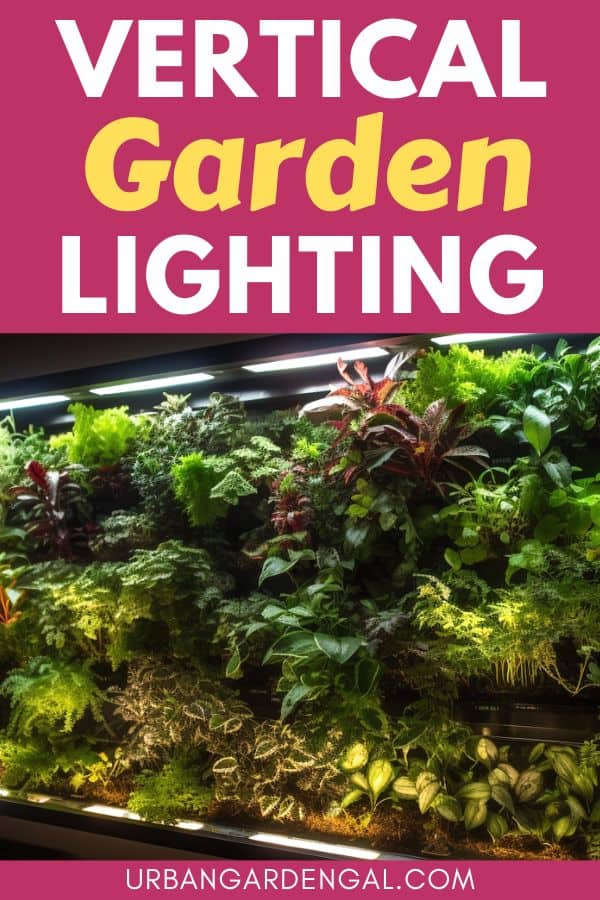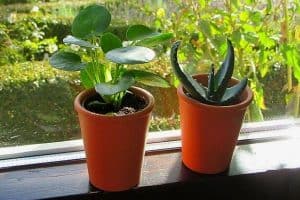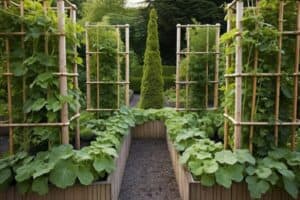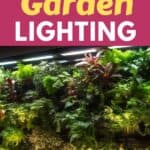Vertical gardens are a beautiful and space-saving way to garden, but without proper lighting, the plants will fail to thrive.
In this article I’ll explain the different types of vertical garden lighting and how to choose best one to suit your needs.
This post contains affiliate links. Please read the disclosure for more info.
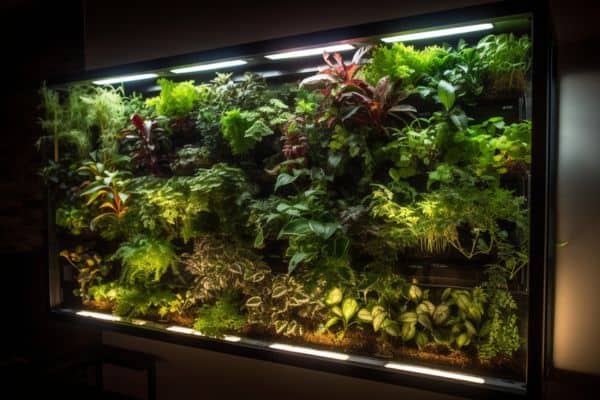
Basics of Vertical Garden Lighting
Natural Light vs Artificial Light
Natural light, such as sunlight from a window, skylight, or outdoors, is an excellent, eco-friendly source of light for vertical gardens.
However, the availability of natural light may not always be consistent, and it might not provide enough light for certain types of plants.
In this case, you can turn to artificial lighting to ensure your plants get the necessary amount of light.
Artificial light helps you control the lighting conditions, including the duration, intensity, and color spectrum, allowing you to tailor the lighting to your plants’ specific needs.
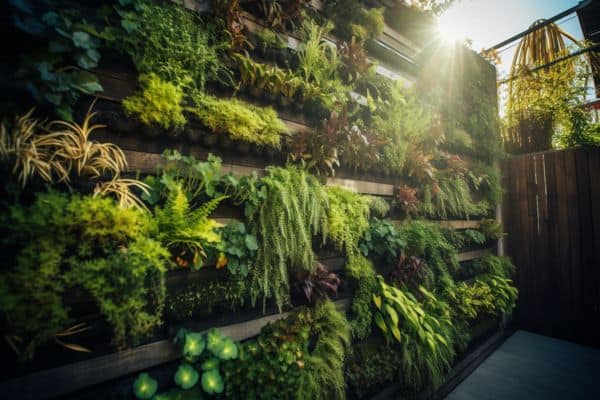
Optimizing Light in Vertical Gardens
Maximizing Natural Light
As a landscape gardener, I know that maximizing natural light is key to the success of a vertical garden.
When I’m designing a vertical garden, I try to choose a location that gets at least six hours of sunlight a day.
Large windows or skylights allow plenty of diffused light to reach your plants, which mimics their natural environment.
If you don’t have ample window space, consider adding mirrors or light-colored wall paint to reflect and redistribute the incoming light.
Using a light meter can help you accurately measure the light intensity so you can determine if you need artificial lights to supplement the natural light.
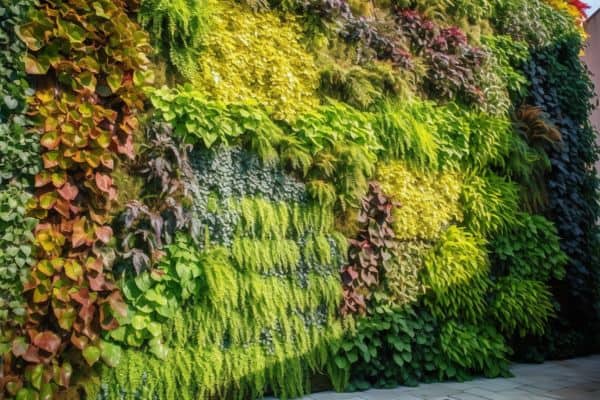
Grow Lights and Color Spectrum
When natural light is insufficient, grow lights provide an effective solution for your vertical garden.
There are several types of energy-efficient grow lights available, each with their own advantages and drawbacks.
When choosing grow lights, consider the following:
- Fluorescent lights: These are energy-efficient and provide cool, balanced light, suitable for seedlings or low-light plants.
- LED lights: LED grow lights offer a full color spectrum which includes red, blue and green light. They are also energy-efficient, making them ideal for a variety of plants.
- HID lights: High-Intensity Discharge (HID) lights, such as Metal Halide and High-Pressure Sodium, emit a sun-like color spectrum.
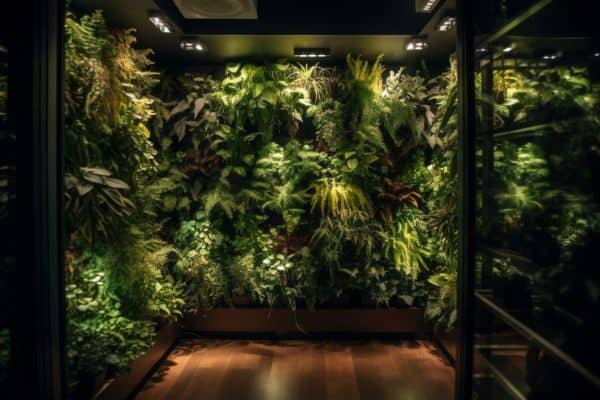
When it comes to choosing the best lighting for your vertical garden, two important factors to consider are Kelvin (K) and Color Rendering Index (CRI).
Kelvin measures the color temperature of a light source.
For plants, a Kelvin rating between 3000K and 5000K is ideal, as it mimics the natural light spectrum and promotes healthy growth.
Color Rendering Index, on the other hand, measures how accurately a light source displays colors compared to natural light.
The University of Vermont Extension recommends a CRI rating of 85 or higher for grow lights to ensure that the plants receive the full spectrum of light they need for healthy growth and development.
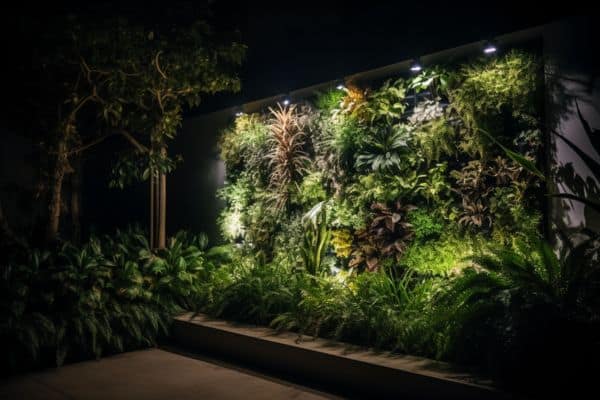
Adjusting Light Intensity
Not all plants require the same amount of light so you’ll need to customize light intensity levels based on your plants’ specific needs.
- High-light plants: Tomatoes or peppers, need at least 6 to 8 hours of direct sunlight or high-intensity grow lights.
- Medium-light plants: Herbs and leafy greens typically need 4 to 6 hours of direct sunlight or medium-intensity grow lights.
- Low-light plants: Plants like ferns or snake plants can thrive with as little as 2 to 4 hours of direct sunlight or low-intensity grow lights. [1]
Vertical Garden Lighting Systems
Spot and Flood Type Bulbs
Spotlights and flood lights are a popular choice for illuminating a vertical garden and these bulbs can provide your plants with the optimal light levels they need to thrive.
Spotlights offer focused lighting in a specific direction, making them ideal for targeted plant growth, while floodlights distribute a wide beam of light for a more general coverage of your vertical garden.
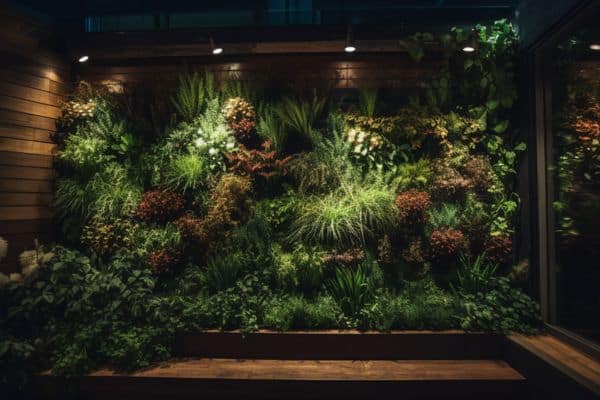
Track Systems
Another practical solution for vertical garden lighting is the use of track systems.
These adaptable setups allow for multiple light fixtures to be mounted along a single track, providing flexibility and control over light distribution.
You can easily adjust the position and angle of the lights to ensure adequate light reaches all areas of your garden.
As your vertical garden grows, you can add more lights to your existing track system.
Landscape Lighting
Incorporate landscape lighting into your outdoor vertical garden design to create a beautiful display that can be enjoyed day and night.
- Use up-lights to highlight your garden’s anchor plants and create dramatic shadows.
- Add spotlights to showcase your living wall’s unique features, such as cascading ferns or vibrant flowers.
- Install subtle pathway lighting that guides visitors through your garden space, so they can safely admire the vertical garden at night.
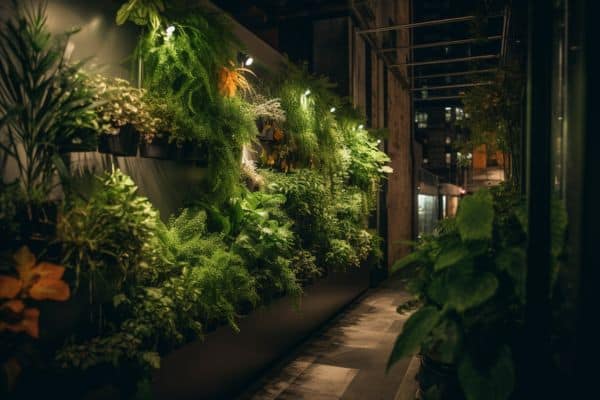
Automating Your Lighting
Once you have chosen the best lighting for your vertical garden, consider adding a timer to automate the light cycles.
This will enable you to customize the duration and intensity of your lighting.
You can set up a timer to turn off the lights at certain times, to conserve energy and keep your electricity costs low.
RELATED ARTICLES
- 11 Vertical Garden Mistakes to Avoid
- How To Grow Gourds Vertically
- 8 Vertical Fence Garden Ideas
- How To Grow Pumpkins Vertically
- How To Grow Kiwi Fruits Vertically
So there are my tips for choosing lighting for your vertical garden. With the right lighting setup, you can create a stunning vertical garden that flourishes all year round.
Are you on Pinterest? I have boards dedicated to Urban Gardens and Gardening Tips that you may find interesting. You can also find me on Facebook.

